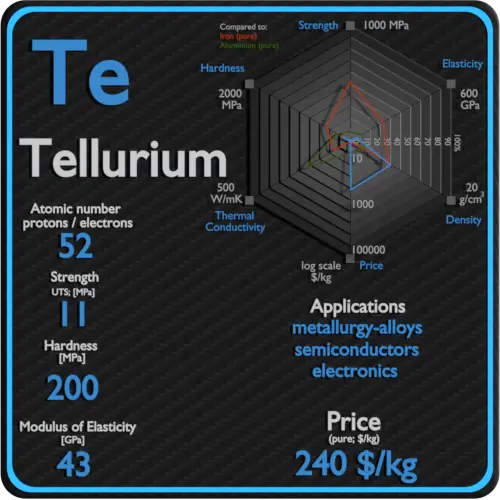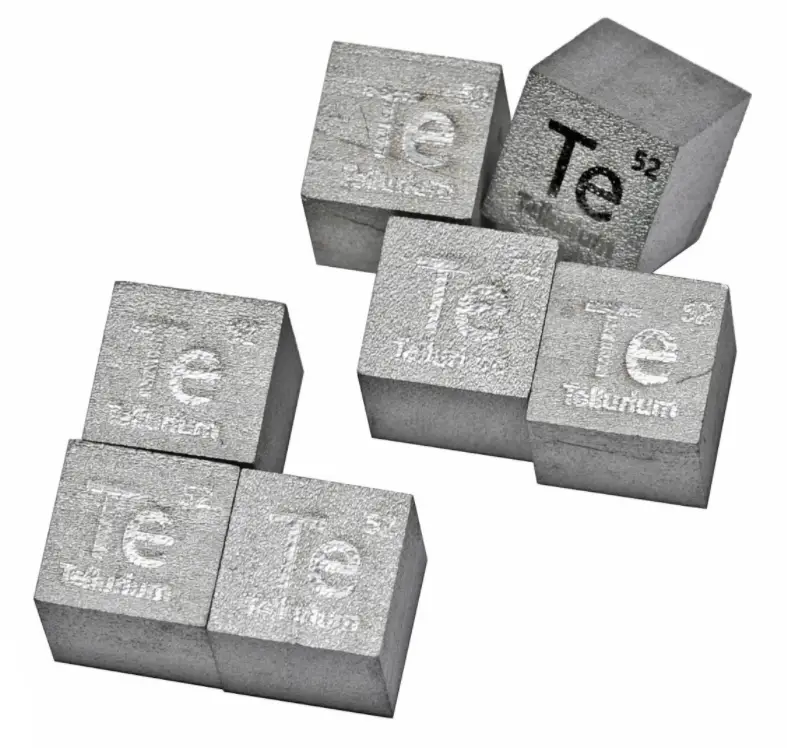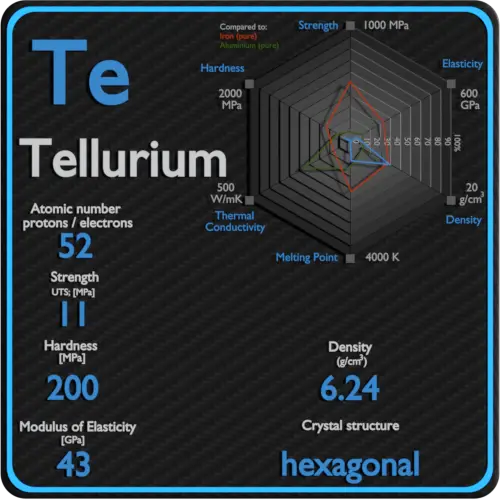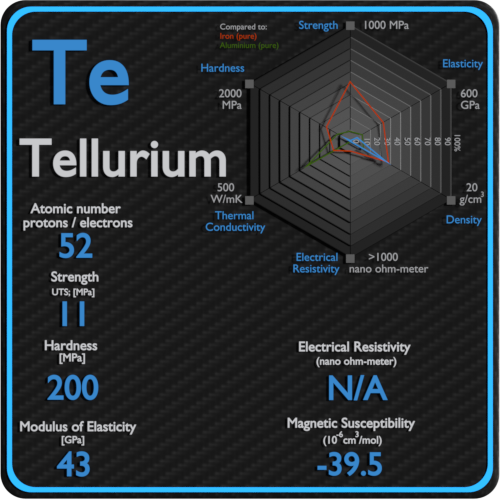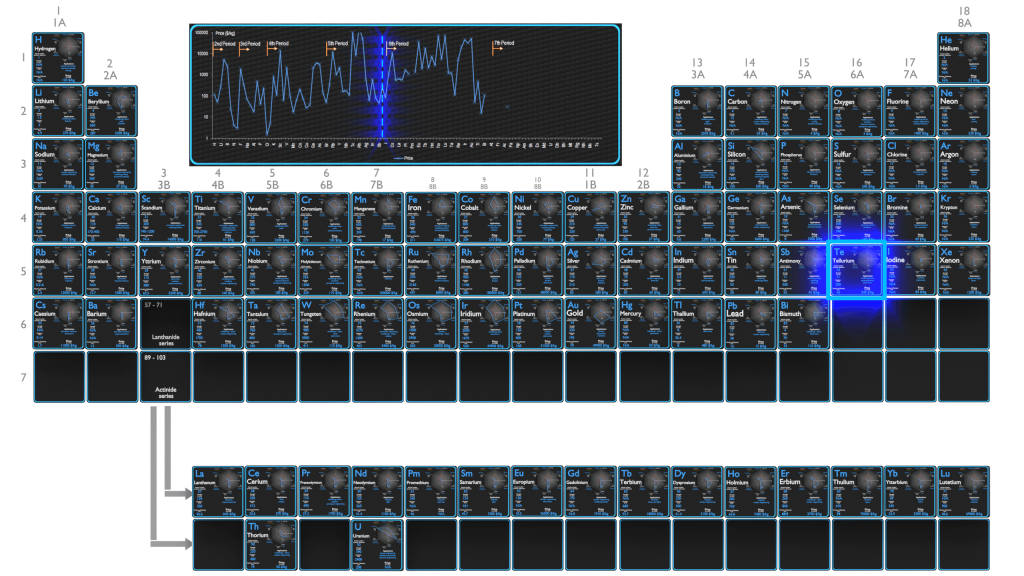About Tellurium
Tellurium is a brittle, mildly toxic, rare, silver-white metalloid. Tellurium is chemically related to selenium and sulfur. It is occasionally found in native form as elemental crystals. Tellurium is far more common in the universe as a whole than on Earth. Its extreme rarity in the Earth’s crust, comparable to that of platinum.
Summary
| Element | Tellurium |
| Atomic number | 52 |
| Element category | Metalloids |
| Phase at STP | Solid |
| Density | 6.24 g/cm3 |
| Ultimate Tensile Strength | 11 MPa |
| Yield Strength | N/A |
| Young’s Modulus of Elasticity | 43 GPa |
| Mohs Scale | 2.3 |
| Brinell Hardness | 200 MPa |
| Vickers Hardness | N/A |
| Melting Point | 449.5 °C |
| Boiling Point | 989.8 °C |
| Thermal Conductivity | 3 W/mK |
| Thermal Expansion Coefficient | 18 µm/mK |
| Specific Heat | 0.2 J/g K |
| Heat of Fusion | 17.49 kJ/mol |
| Heat of Vaporization | 52.55 kJ/mol |
| Electrical resistivity [nanoOhm meter] | — |
| Magnetic Susceptibility | −39.5e-6 cm^3/mol |
Applications of Tellurium
The largest consumer of tellurium is metallurgy in iron, stainless steel, copper, and lead alloys. Tellurium is used in alloys, mostly with copper and stainless steel, to improve their machinability. When added to lead it makes it more resistant to acids and improves its strength and hardness. Tellurium has been used to vulcanise rubber, to tint glass and ceramics, in solar cells, and as a catalyst in oil refining. Tellurium as a tellurium suboxide is used in the media later of several types of rewritable optical discs including CD-RW, DVD-RW and rewritable blu-ray discs. It can be doped with silver, gold, copper or tin in semiconductor applications. The use of high-purity tellurium in cadmium telluride solar cells is very promising. Some of the highest efficiencies for electric power generation have been obtained by using this material, but this application has not yet caused demand to increase significantly.
Production and Price of Tellurium
Raw materials prices change daily. They are primarily driven by supply, demand and energy prices. In 2019, prices of pure Tellurium were at around 240 $/kg.
Commercial quantities of selenium are recovered as a byproduct of the electrolytic refining of copper where it accumulates in anode residues. Treatment of 1000 tons of copper ore typically yields one kilogram (2.2 pounds) of tellurium. Commercial-grade tellurium is usually marketed as 200-mesh powder but is also available as slabs, ingots, sticks, or lumps. The year-end price for tellurium in 2000 was US$14 per pound. In recent years, the tellurium price was driven up by increased demand and limited supply, reaching as high as US$100 per pound in 2006.
Source: www.luciteria.com
Mechanical Properties of Tellurium
Strength of Tellurium
In mechanics of materials, the strength of a material is its ability to withstand an applied load without failure or plastic deformation. Strength of materials basically considers the relationship between the external loads applied to a material and the resulting deformation or change in material dimensions. In designing structures and machines, it is important to consider these factors, in order that the material selected will have adequate strength to resist applied loads or forces and retain its original shape. Strength of a material is its ability to withstand this applied load without failure or plastic deformation.
For tensile stress, the capacity of a material or structure to withstand loads tending to elongate is known as ultimate tensile strength (UTS). Yield strength or yield stress is the material property defined as the stress at which a material begins to deform plastically whereas yield point is the point where nonlinear (elastic + plastic) deformation begins.
See also: Strength of Materials
Ultimate Tensile Strength of Tellurium
Ultimate tensile strength of Tellurium is 11 MPa.
Yield Strength of Tellurium
Yield strength of Tellurium is N/A.
Modulus of Elasticity of Tellurium
The Young’s modulus of elasticity of Tellurium is N/A.
Hardness of Tellurium
In materials science, hardness is the ability to withstand surface indentation (localized plastic deformation) and scratching. Brinell hardness test is one of indentation hardness tests, that has been developed for hardness testing. In Brinell tests, a hard, spherical indenter is forced under a specific load into the surface of the metal to be tested.
Brinell hardness of Tellurium is approximately 200 MPa.
The Vickers hardness test method was developed by Robert L. Smith and George E. Sandland at Vickers Ltd as an alternative to the Brinell method to measure the hardness of materials. The Vickers hardness test method can be also used as a microhardness test method, which is mostly used for small parts, thin sections, or case depth work.
Vickers hardness of Tellurium is approximately N/A.
Scratch hardness is the measure of how resistant a sample is to permanent plastic deformation due to friction from a sharp object. The most common scale for this qualitative test is Mohs scale, which is used in mineralogy. The Mohs scale of mineral hardness is based on the ability of one natural sample of mineral to scratch another mineral visibly.
Tellurium is has a hardness of approximately 2.3.
See also: Hardness of Materials
Tellurium – Crystal Structure
A possible crystal structure of Tellurium is hexagonal structure.
In metals, and in many other solids, the atoms are arranged in regular arrays called crystals. A crystal lattice is a repeating pattern of mathematical points that extends throughout space. The forces of chemical bonding causes this repetition. It is this repeated pattern which control properties like strength, ductility, density, conductivity (property of conducting or transmitting heat, electricity, etc.), and shape. There are 14 general types of such patterns known as Bravais lattices.
See also: Crystal Structure of Materials
Crystal Structure of Tellurium
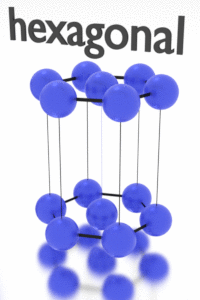
Thermal Properties of Tellurium
Tellurium – Melting Point and Boiling Point
Melting point of Tellurium is 449.5°C.
Boiling point of Tellurium is 989.8°C.
Note that, these points are associated with the standard atmospheric pressure.
Tellurium – Thermal Conductivity
Thermal conductivity of Tellurium is 3 W/(m·K).
The heat transfer characteristics of a solid material are measured by a property called the thermal conductivity, k (or λ), measured in W/m.K. It is a measure of a substance’s ability to transfer heat through a material by conduction. Note that Fourier’s law applies for all matter, regardless of its state (solid, liquid, or gas), therefore, it is also defined for liquids and gases.
Coefficient of Thermal Expansion of Tellurium
Linear thermal expansion coefficient of Tellurium is 18 µm/(m·K)
Thermal expansion is generally the tendency of matter to change its dimensions in response to a change in temperature. It is usually expressed as a fractional change in length or volume per unit temperature change.
Tellurium – Specific Heat, Latent Heat of Fusion, Latent Heat of Vaporization
Specific heat of Tellurium is 0.2 J/g K.
Heat capacity is an extensive property of matter, meaning it is proportional to the size of the system. Heat capacity C has the unit of energy per degree or energy per kelvin. When expressing the same phenomenon as an intensive property, the heat capacity is divided by the amount of substance, mass, or volume, thus the quantity is independent of the size or extent of the sample.
Latent Heat of Fusion of Tellurium is 17.49 kJ/mol.
Latent Heat of Vaporization of Tellurium is 52.55 kJ/mol.
Latent heat is the amount of heat added to or removed from a substance to produce a change in phase. This energy breaks down the intermolecular attractive forces, and also must provide the energy necessary to expand the gas (the pΔV work). When latent heat is added, no temperature change occurs. The enthalpy of vaporization is a function of the pressure at which that transformation takes place.
Tellurium – Electrical Resistivity – Magnetic Susceptibility
Electrical property refers to the response of a material to an applied electric field. One of the principal characteristics of materials is their ability (or lack of ability) to conduct electrical current. Indeed, materials are classified by this property, that is, they are divided into conductors, semiconductors, and nonconductors.
See also: Electrical Properties
Magnetic property refers to the response of a material to an applied magnetic field. The macroscopic magnetic properties of a material are a consequence of interactions between an external magnetic field and the magnetic dipole moments of the constituent atoms. Different materials react to the application of magnetic field differently.
See also: Magnetic Properties
Electrical Resistivity of Tellurium
Electrical resistivity of Tellurium is — nΩ⋅m.
Electrical conductivity and its converse, electrical resistivity, is a fundamental property of a material that quantifies how Tellurium conducts the flow of electric current. Electrical conductivity or specific conductance is the reciprocal of electrical resistivity.
Magnetic Susceptibility of Tellurium
Magnetic susceptibility of Tellurium is −39.5e-6 cm^3/mol.
In electromagnetism, magnetic susceptibility is the measure of the magnetization of a substance. Magnetic susceptibility is a dimensionless proportionality factor that indicates the degree of magnetization of Tellurium in response to an applied magnetic field.
